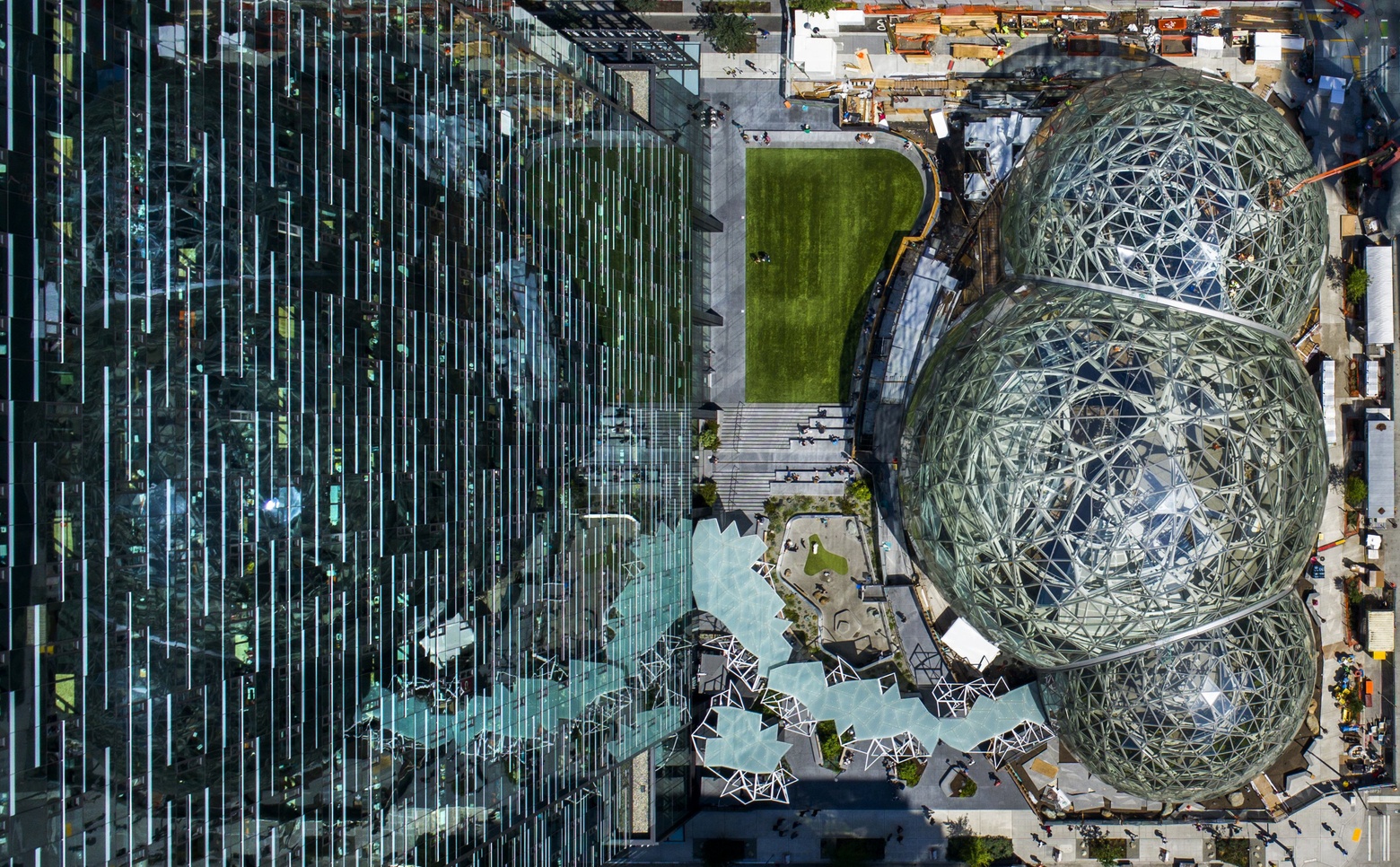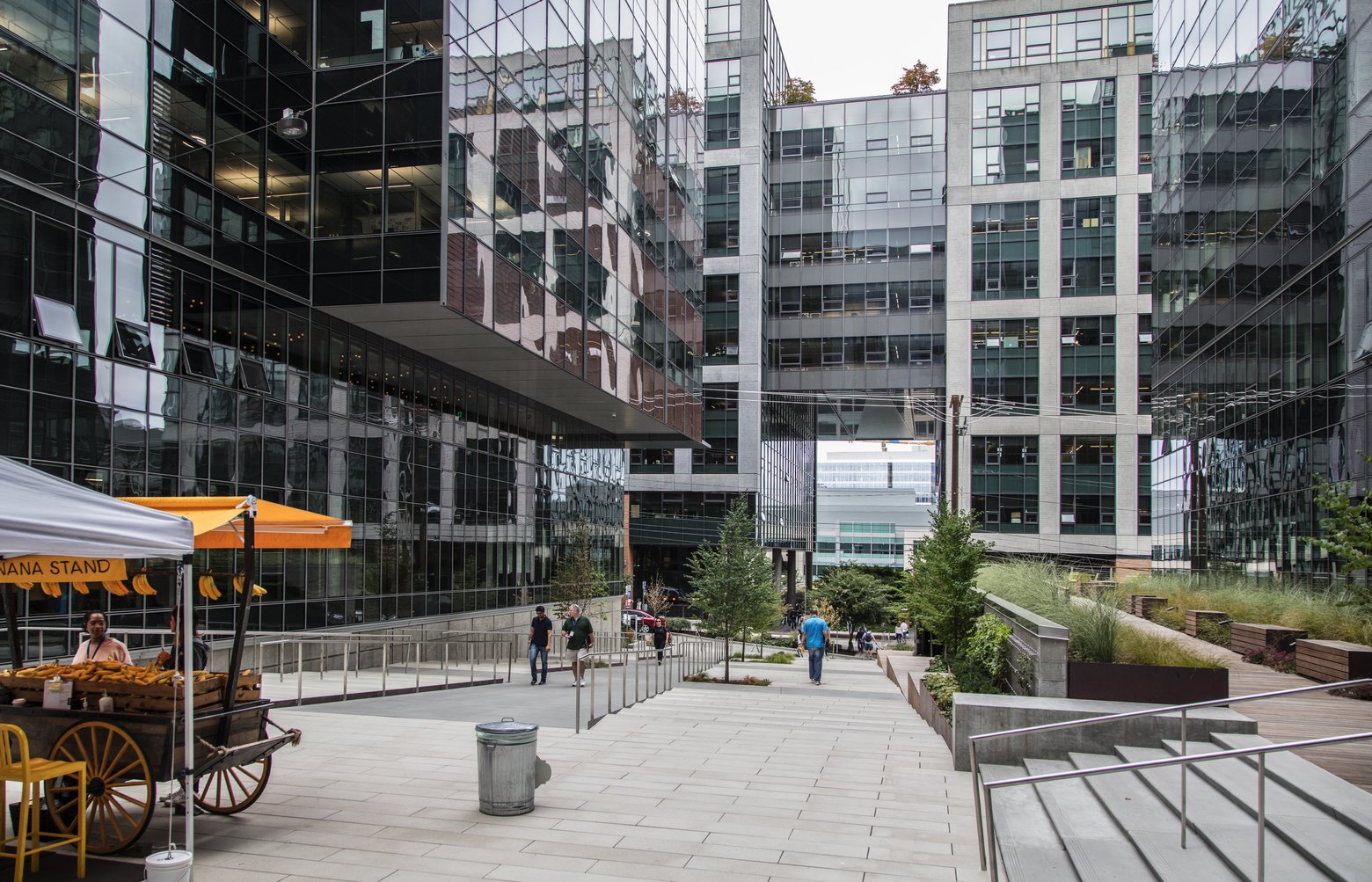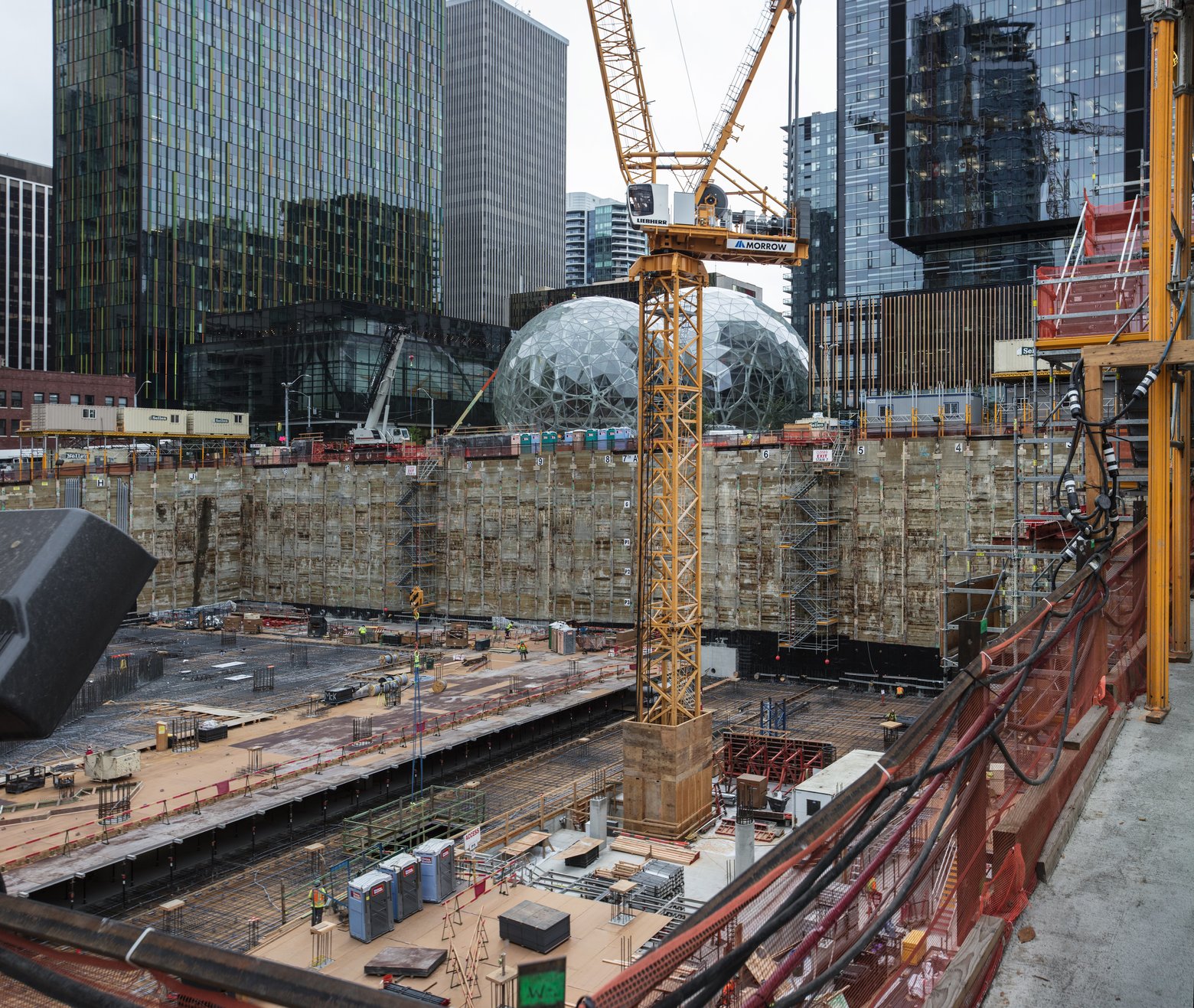Amazon so dominates Seattle that it has as much office space as the city’s next 40 biggest employers combined. And the growth continues: Amazon’s Seattle footprint of 8.1 million square feet is expected to soar to more than 12 million square feet within five years.
Amazon’s extraordinary growth has turned Seattle into the biggest company town in America.
Amazon now occupies a mind-boggling 19 percent of all prime office space in the city, the most for any employer in a major U.S. city, according to a new analysis conducted for The Seattle Times.
Amazon’s footprint in Seattle is more than twice as large as any other company in any other big U.S. city, and the e-commerce giant’s expansion here is just getting started.
The swarms of 20-somethings crowding into South Lake Union every morning represent an urban campus that is unparalleled in the United States — and they have helped transform Seattle, for better or worse. Amazon’s rapid rise has fueled an economy that has driven up wages and lowered unemployment, but also produced gridlock on the roads and sky-high housing prices.
And while Seattle’s booming economy is often attributed to a wide variety of factors, increasingly, it’s all about one company.
Amazon now occupies more office space than the next 40 biggest employers in the city combined.
And that’s only the beginning: Amazon’s Seattle footprint of 8.1 million square feet is expected to soar to more than 12 million square feet within five years.
How many companies does it take to equal Amazon’s office space in Seattle?
It takes 43 companies to match Amazon’s 8.1 million square feet of office space in Seattle. Hover or tap on a rectangle to see details about each company’s real estate.
Amazon’s supremacy in e-commerce and cloud computing has translated, locally, into an avalanche of glass, steel, people and money. It’s given Seattle more prominence as a magnet for talent from all over the world, and reshaped formerly forlorn parts of the city, into vibrant live-work-and-play neighborhoods.
The company’s unparalleled impact in determining Seattle’s fortunes may give some pause to those who experienced the downturn of the 1970s, when the shine of “Jet City” was tarnished as Boeing cut about two-thirds of its huge local workforce.
“Seattle’s been through this before,” said Tracey Seslen, a professor at the University of Washington’s Foster School of Business. “If Amazon were to leave, that would create a giant hole in their wake.”
However, unlike Boeing, whose local operations focus on the single business of building airplanes, Amazon runs a vast web of mutually reinforcing but diverse businesses, from selling computing power, to retailing nearly everything, to publishing books and producing films.
John Schoettler, Amazon’s director of real estate, says that all he’s experienced in his nearly two decades at Amazon is “steady, continued growth,” the result of the company’s zealous focus on satisfying customers.
The legacy of what so far amounts to $4 billion spent by the company on real estate here will be long-lasting, he said: “These buildings will stand for hundreds of years.”
How we got here
For this story, the real-estate data firm CoStar provided a list of all office tenants in the nation’s 20 biggest cities by population, looking at only Class A offices, the modern buildings used by the vast majority of major employers.
While other company campuses may be larger and more dominant in some suburbs — think Microsoft in Redmond, or Apple, Google and Facebook in Silicon Valley — in big cities, corporate tenancy is generally fragmented.
For example, financial giant Citi has 3.7 million square feet in New York — making it the second-largest major-city office tenant in absolute terms after Amazon. But it represents less than 3 percent of Class A office space in the Big Apple.
That’s typical: In most big cities, the top employer has less than 5 percent of local office space.
Among the country’s largest 20 cities, only Columbus, Ohio — where insurer Nationwide occupies 16 percent of office space — has a situation comparable in its dominance to Amazon. But it’s still less than half of Amazon’s total square footage.

In Seattle itself, Amazon is in a league of its own. Its footprint is nearly 20 times greater than that of the next-biggest employer.
Next in size after Amazon, Safeco Insurance and the University of Washington each occupy about 400,000 square feet of office space in Seattle, followed by several companies with about 300,000 square feet each: Tableau, Zillow, Zulily, Nordstrom, F5 Networks, Facebook and the U.S. Department of Labor.
Before its collapse last decade, Washington Mutual occupied about 1.6 million square feet downtown, more than any other company. It took years for the downtown office market to recover after WaMu was absorbed by JPMorgan Chase and its headquarters employees were dispersed. The market only fully bounced back once the recession was fully in the rearview mirror and Amazon began expanding earlier this decade.
‘A sea of parking lots’
Amazon got its start in a Bellevue garage in 1994, and it first grew without much of a plan — its employees were scattered in various downtown Seattle buildings and in the former Pacific Medical Center building on Beacon Hill. When Schoettler, the Amazon real-estate executive, joined the company in 2001, it had 630,000 square feet in Seattle.
In 2005, Schoettler said, he told CEO Jeff Bezos that the company needed a plan, and Bezos agreed. His only condition was that Amazon would stay in downtown Seattle, Schoettler said.
That coincided with the reversal of a decades-long outflow from U.S. cities to their suburbs: By staying in the urban core, Amazon would attract members of the hip creative class.
“It was a very conscious decision we made,” Schoettler said.
The easiest place for Amazon to grow into was South Lake Union. “It was essentially a sea of parking lots,” Ada Healy, vice president of real estate at Vulcan, billionaire Paul Allen’s real-estate firm — which built much of Amazon’s campus — said at a recent real-estate conference.
Allen had paid for 11.5 acres he intended to donate to an urban park project called the Seattle Commons. But when voters turned it down — twice, most recently in 1996 — the land went to Allen. His Vulcan development company then gobbled up more land in the neighborhood over the following decade, giving it about 60 acres.
Amazon’s first request was for about 2 million square feet, to be delivered in 2010. That initial expansion, Schoettler said at the real-estate conference, “was supposed to last us through 2016.”
As it turned out, by then the company would have three times as much.
That’s because its Seattle payroll was growing even faster than expected. The company now employs about 40,000 employees in Seattle, up from 5,000 in 2010.
Now it is by far the largest employer in the city. Under Amazon’s current plans, there will be room in Seattle for more than 55,000 Amazonians at the beginning of next decade.
Amazon later acquired another 2 million square feet from Vulcan, and some 3.3 million square feet from Clise Properties in the Denny Regrade, formerly a realm of cheap motels and car dealerships. There, Amazon is building the epicenter of its campus around three 40-story towers and three giant spheres.
Altogether, Amazon occupies or plans to be in about three dozen office buildings in Seattle.
This breakneck rate of expansion, in contiguous land, “would be difficult to do in a lot of other metropolitan areas,” Schoettler said.
Amazon’s expansion has led, in the short time since the end of the recession, to a “record level of private investment,” as well as significant levels of public infrastructure investment, according to John Scholes, CEO of the Downtown Seattle Association.
Over the last decade, South Lake Union has seen $668 million in infrastructure improvements, from a new electrical substation under construction to the revamped Mercer Street to a new streetcar line to upgraded parks. About one-sixth of the cost has come from private investment, the rest from ratepayers and public funds.
Housing, traffic impacts
Amazon has become the go-to scapegoat for people complaining about Seattle’s problems associated with growth, like housing prices and clogged streets. And while it’s certainly not the only reason Seattle is bursting at the seams, Amazon makes up a disproportionate share of the city’s rapid growth.
Apartment rents this year are 63 percent higher than in 2010, as Seattle has become the fastest-growing city in the country.
Home costs are rising faster here than anywhere in the nation, and have doubled in the past five years, pushing the middle class to surrounding, less expensive towns.
Seattle now also has the nation’s third-highest concentration of mega-commuters — people traveling at least 90 minutes each way to work. Their numbers have grown 72 percent in five years.
Buses are more packed than ever, and lines that run along the Amazon campus are often standing-room-only during rush hour; Metro drivers at times have to leave commuters waiting outside an Amazon office because their buses are full. Local officials even added buses to accommodate the crush of Amazon interns that arrived this summer.
“It’s hard to keep pace in terms of development of infrastructure,” said Simon Stevenson, the director of the Runstad Center for Real Estate Studies at the University of Washington. But overall, “the positives, economically, outweigh the potential of the downside.”
Wages here are rising faster than anywhere else in the country, driven by Amazon’s hiring binge of employees making six figures. Unemployment is near record lows.
Local celebrity chef Tom Douglas, who operates 16 restaurants in the area, including several in the South Lake Union epicenter of Amazon’s boom, has seen the transformation since he arrived in Seattle in 1984.
He says that despite the traffic and high cost of living, he’d rather have the growth happening here than in another city.
“There’s this romantic notion about Seattle. I’ve been here long enough to see both sides of this,” he said. Douglas recalled how the opening of Dahlia Lounge on Fourth Avenue, in 1989, “was a tough go.”
“There were crackheads in the 7-Eleven next door to us. We barely made it,” he said. “We should be thankful for the prosperity we have right now. I think we should embrace it.”
Amazon has also begun turning around the reputation that it’s done little to alleviate the problems stemming from Seattle’s growth. The company recently said it would house a homeless shelter in one of its new offices and is offering nonprofits space for restaurants in some of its other buildings. It donated $10 million to the University of Washington last fall, created plazas for public use and has helped underwrite the South Lake Union streetcar.
A real-estate revolution
Amazon’s growth has been so substantial that it can single-handedly skew the city’s core office market, said Matthew Gardner, the chief economist of Windermere Real Estate.
In the last quarter of 2016, for instance, all non-Amazon employers in Seattle’s greater downtown region shrank by a combined 150,000 square feet of office space. But Amazon gained 408,000 square feet by itself, making it a positive quarter for the market overall.
“They’re kind of almost juicing the market in some respects,” Gardner said.
Amazon’s supercharged growth has made it harder for other companies to find available offices in the entire downtown core, said Eric Blohm, a senior managing director for Savills Studley, which represents companies looking for office space.
The company’s expansive effect is being felt well beyond the South Lake Union and Denny Regrade neighborhoods. Amazon recently leased 400,000 square feet in Bellevue, and various real-estate sources said the company is interested in taking over the entire office portion of a forthcoming 58-story downtown Seattle skyscraper at Rainier Square, scheduled to open in 2019. Amazon declined to comment on the potential expansion.
If that move happens, it would have a cascading effect on availability for other businesses in the core of downtown, outside of South Lake Union, Blohm said.
Previously, he said, “A landlord in that (downtown) market couldn’t really say, ‘Oh we’re holding out for Amazon’ … Now they would have some ammunition to say that.”
Amazon’s growing mass has also created a gravitational pull for other big tech companies on the prowl for employees. Google and Facebook have set up big offices in Seattle’s urban core, and by the end of the decade they are both poised to be among the top 10 tenants in the city.
Apple, Airbnb, Uber, the makers of Snapchat and others have also set up shop downtown following Amazon’s success in recruiting engineering talent.
That, said Seslen, the University of Washington professor, helps strengthen the local tech community.
Because Amazon does not have an isolated suburban campus like Microsoft, “there’s more opportunity for employees at Amazon to network with their peers at other companies,” she said.
But that influx of deep-pocketed tech giants also makes it more difficult and expensive for smaller businesses to find space.
“Some landlords aren’t even talking to us about (leasing) full floors,” Blohm said. “They’re holding out for the full building user. Or they’ll say, ‘Get in line, you’re third in line, we’re talking with other people.’ ”
Revitalizing retail
Although Amazon, the world’s largest e-commerce company, has been long criticized for destroying Main Street retail jobs, in Seattle’s case the influx of Amazon jobs has been accompanied by a boom in local retail.
Between 2010 and 2015, retail sales in downtown Seattle have grown more than 19 percent annually — much faster than in nearby cities, according to the Downtown Seattle Association. Just in 2015, sales spiked 27.5 percent to some $1.4 billion. By comparison, Bellevue sales grew by 13.3 percent and Redmond’s by 5.7 percent that year.
Scholes, the Downtown Seattle Association president, says there’s been a shift toward beverage and food services, a corollary of the expanding downtown residential population, many of them well-paid.
Even department stores — a category that’s been eviscerated by Amazon’s success elsewhere — have been buoyed here by downtown Seattle’s increasing hubbub. Their 2015 sales rose 224 percent from the recession’s tail end in 2010, while across the lake in Bellevue, sales grew 64 percent.
Stevenson, the UW real-estate expert, said that localized retail surge is the result of Amazon breaking with the suburban campus tradition of software companies.
“Actually the benefit to downtown is enormous,” he said. “The development and revitalization would not have happened this quick without Amazon moving there and expanding that much.”


